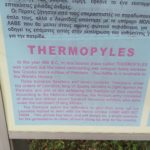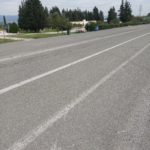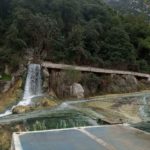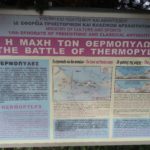Welcome to Thermopylae, a historically significant location in Greece. This iconic site has a significant place in history and has evolved over time. In this section, we will explore the present-day condition of Thermopylae, including its geographical location, accessibility, and how it looks in the modern era.
Key Takeaways:
- Thermopylae is an iconic historical site in Greece with significant historical importance.
- The site has evolved over time and continues to attract visitors interested in experiencing its rich history and natural beauty.
- Thermopylae is located in Greece, and visitors can easily reach the site via various modes of transportation.
- The site offers a unique experience that blends the past with the present, including ancient ruins, modern structures, and picturesque natural surroundings.
- Visitors can learn about the local culture and traditions that surround Thermopylae and explore nearby attractions, accommodations, and dining options.
The History of Thermopylae
To understand the significance of Thermopylae today, we must first delve into its rich history. The Battle of Thermopylae, fought in 480 BC between the Persian Empire and a coalition of Greek city-states, was a defining moment in ancient Greek history.
Led by the legendary Spartan King Leonidas, a small force of Greek soldiers held off the Persian army for three days at the narrow pass of Thermopylae, allowing the Greeks time to prepare for the coming battle. While the Greeks ultimately lost the battle, their bravery and sacrifice gave them a crucial advantage in the war, leading to their eventual victory at the Battle of Salamis.
The Battle of Thermopylae
| Date | Location | Combatants | Outcome |
|---|---|---|---|
| August or September 480 BC | Thermopylae, Greece | Persian Empire vs. Greek city-states | Persian victory |
The Battle of Thermopylae has become a symbol of bravery and self-sacrifice in the face of overwhelming odds. It has inspired countless books, movies, and works of art over the centuries, cementing its place in popular culture and history.
Today, visitors to Thermopylae can explore the site where this historic battle took place, as well as learn about the broader context of ancient Greek history and culture.
Location of Thermopylae
If you’re wondering where is Thermopylae now, this section will give you all the information you need. Thermopylae is located in central Greece, near the Gulf of Malis. It’s about 140 kilometers northwest of Athens and 40 kilometers southeast of Lamia, the capital of the regional unit of Phthiotis.
The site is easily accessible by car or bus from major Greek cities, and there are also organized tours available. If you’re traveling from Athens, you can take the E75 highway and exit towards Thermopylae. The journey should take around two and a half hours, depending on traffic and weather conditions.
Location of Thermopylae
| City | Distance from Thermopylae | Travel Time |
|---|---|---|
| Athens | 140 km | 2.5 hours by car/bus |
| Lamia | 40 km | 30 minutes by car/bus |
| Thessaloniki | 330 km | 4 hours by car/bus |
When planning your trip, it’s important to note that there are no direct train routes to Thermopylae, but regular train services operate to Lamia from Athens and other parts of Greece.
The Ancient Ruins of Thermopylae
Thermopylae’s ancient ruins stand as a testament to the bravery of King Leonidas and his Spartan warriors who fought against the Persian Empire in 480 BC. But does Thermopylae still exist today? The answer is yes. Visitors can still witness the remnants of the famous battle and the pass of Thermopylae itself.
The Memorial to the Fallen Spartans
One of the most notable ruins at Thermopylae is the Memorial to the Fallen Spartans. Located at a spot that was once the site of fierce fighting, this monument pays tribute to the Spartan soldiers who lost their lives in the battle.
The inscription on the memorial reads:
“Oh stranger, tell the Lacedaemonians that we lie here, obedient to their words.”
This quote is a reference to the orders given to the Spartans by their king, Leonidas, to hold the pass at all costs and to avoid leaving their post even in the face of certain death.
The Pass of Thermopylae
The pass of Thermopylae, a narrow coastal strip of land, was the site of the famous battle between the Greeks and the Persians. The pass was once a vital strategic point for controlling the movement of troops and armies.
Although the pass looks different today than it did in ancient times, it is still recognizable as a significant landmark. The modern-day road that runs through the pass follows the same path as the ancient road, allowing visitors to experience the same awe-inspiring views that the Spartan warriors had when they stood against the invading Persian army.
Modern Structures and Monuments
Thermopylae today offers visitors the opportunity to explore modern structures and monuments that pay homage to its rich history. From statues of brave warriors to museums showcasing artifacts from the battle, the site is a must-visit for history enthusiasts.
Leonidas Monument
The imposing statue of the legendary Spartan King Leonidas stands proudly at Thermopylae, serving as a reminder of the valiant sacrifices made during the famous Battle of Thermopylae. The statue overlooks the pass of Thermopylae, where Leonidas and his brave warriors fought against the Persian Empire in 480 BC.
Museum of the Battle of Thermopylae
The Museum of the Battle of Thermopylae is a great place to learn more about the region’s history. Visitors can marvel at a variety of exhibits, including armor, weapons, and other artifacts that date back to the battle. The museum provides a detailed account of the events that unfolded during the battle and its importance in shaping Greek history.
Memorial to the Fallen Spartans
The Memorial to the Fallen Spartans at Thermopylae serves as a reminder of the bravery and heroism of the legendary Spartan warriors who fought and died in the Battle of Thermopylae. The memorial is a testament to the courage and sacrifice of the men who fought to defend Greece against the Persian Empire.
Modern Sculptures
In addition to the historical monuments, Thermopylae also boasts a range of contemporary sculptures that pay tribute to the region’s rich cultural heritage. These include sculptures depicting famous Greek gods and goddesses, as well as famous figures from ancient Greek history.
Overall, Thermopylae today offers a unique combination of ancient history and modern culture. Its structures and monuments provide an insight into the region’s rich history and serve as a reminder of the bravery and heroism of the Spartan warriors who fought for their country over 2,500 years ago.
Natural Surroundings of Thermopylae
Thermopylae today is not only known for its rich history, but also for its picturesque natural surroundings. Visitors can immerse themselves in the beauty of the landscape, which includes nearby mountains and the famous thermal springs.
One of the most notable features of the area is the hot springs, which have been attracting visitors for centuries. These natural springs are believed to have healing properties and are a popular spot for relaxation and rejuvenation.
The nearby mountains also offer stunning views that are worth exploring. Visitors can hike or drive to the top of these peaks and enjoy breathtaking scenery of the surrounding area.
The Spercheios River
In addition to the mountains and hot springs, the Spercheios River is another natural feature of Thermopylae that draws visitors. The river runs through the valley and provides a serene atmosphere for relaxation and exploration.
Visitors can take a walk along the riverbank and enjoy the peaceful sound of the flowing water. The river is also popular for fishing and kayaking, providing an exciting outdoor activity for nature enthusiasts.
The Gorgopotamos Bridge
The Gorgopotamos Bridge is another natural feature that is worth visiting. This historic bridge played a significant role in World War II, as it was destroyed by Greek resistance fighters to prevent the Nazis from using it to transport troops.
Today, visitors can explore the bridge and learn about its history and significance in shaping modern Greece. The surrounding area also offers stunning views of the Gorgopotamos River and is a popular spot for outdoor activities such as hiking and cycling.
Visiting Thermopylae
Planning a visit to Thermopylae? Here’s what you need to know to make the most of your time there.
Getting There
Thermopylae is located in central Greece, approximately 190 kilometers northwest of Athens. The easiest way to reach the site is by car, with ample parking available for visitors. Alternatively, you can take a bus or train to the nearby town of Lamia and then travel to Thermopylae by taxi or rental car.
Opening Hours and Admission
Thermopylae is open to visitors year-round, from sunrise to sunset. Admission is free, and there are no restrictions on exploring the site on foot. However, be aware that some areas may be restricted due to ongoing archaeological work, so always follow the guidance of onsite staff.
What to See and Do
Thermopylae offers a wealth of opportunities for visitors to explore its rich history and natural beauty. Start by visiting the famous Leonidas monument, which stands as a tribute to the brave Spartan King and his warriors who fought against the Persian army. Nearby, you can also explore the hot springs that give Thermopylae its name, which are known for their healing properties.
For those interested in learning more about the history of the site, there are several museums to visit. The Thermopylae Museum contains artifacts from the battle, while the Leonidas Museum offers a more detailed look at the life of the Spartan King.
Where to Stay and Eat
There are several options for accommodations near Thermopylae, ranging from budget-friendly guesthouses to luxurious resorts. The nearby town of Lamia also offers a variety of dining options, from traditional Greek tavernas to international cuisine.
Final Thoughts
Visiting Thermopylae is a unique experience that immerses you in both history and nature. Whether you come to pay homage to the brave warriors who fought in the famous battle or simply to enjoy the stunning scenery, you’re sure to leave with a deeper appreciation for this iconic Greek site.
Local Culture and Traditions
Thermopylae today not only offers a glimpse into ancient history but also a chance to experience the rich local culture and traditions of the surrounding communities. Here are some highlights to explore:
Festivals and Celebrations
Throughout the year, nearby villages and towns host a variety of festivals and celebrations that showcase the region’s cultural heritage. One such event is the “Festival of Leonidas,” which takes place every August in the town of Sparta. Visitors can experience traditional music, dance, and food while honoring the memory of the legendary Spartan king.
Local Cuisine
The area surrounding Thermopylae is known for its delicious, traditional Greek cuisine. Visitors can sample locally produced cheese, olive oil, and honey, as well as fresh seafood caught in the nearby Aegean Sea. Many restaurants in the region also offer “mezedes,” small plates of various dishes, perfect for sharing with friends and family.
Handicrafts and Art
The villages surrounding Thermopylae are home to many artisans and craftsmen who create beautiful handmade products. From ceramics and pottery to textiles and jewelry, visitors can purchase unique and authentic souvenirs to take home as a reminder of their trip to Greece.
Nearby Attractions
When visiting Thermopylae, there are many nearby attractions that you won’t want to miss. From ancient ruins to stunning natural landscapes, there is something for everyone to enjoy. Here are some of the top attractions near Thermopylae today:
Delphi
Located just two hours north of Thermopylae, the ancient site of Delphi is a must-visit destination for history buffs. Once considered the center of the world by the ancient Greeks, Delphi was a place of worship and pilgrimage, and its ruins are still incredibly well-preserved today. Explore the famous Temple of Apollo, where the Oracle of Delphi prophesied the future, and soak in the stunning mountain views that surround the site.
Meteora
Another incredible natural wonder near Thermopylae is the Meteora monasteries. These stunning rock formations rise up from the earth like pillars, and perched on top of them are a series of ancient monasteries that date back to the 14th century. Visitors can hike up to the monasteries or take a scenic drive to take in the breathtaking views.
Mount Pelion
If you’re looking for a picturesque escape from the hustle and bustle of city life, Mount Pelion is the perfect destination. This beautiful mountain range is located just an hour’s drive from Thermopylae and is home to quaint villages, lush forests, and stunning beaches. Take a leisurely hike through the woods or spend a day lounging on the beach in one of the mountain’s seaside towns.
- Other nearby attractions worth checking out include:
- The Byzantine castle of Lamia
- The ancient ruins of Eretria
- The picturesque town of Kamena Vourla
With so much to see and do in the surrounding area, a visit to Thermopylae is an excellent opportunity to explore the rich history and natural beauty of Greece. Don’t miss your chance to experience everything this incredible region has to offer!
Accommodations and Dining Options
When visiting Thermopylae, there are several accommodation options available nearby, ranging from budget-friendly guesthouses to luxurious hotels. Here are some top picks:
| Hotel Name | Description | Price Range |
|---|---|---|
| Thermopylae Inn | A cozy guesthouse with comfortable rooms and a traditional Greek breakfast included. Located just a short distance from the Thermopylae battlefield. | $ |
| Artemis Hotel | A modern hotel with a pool and an on-site restaurant. Situated in the nearby town of Lamia, approximately a 30-minute drive from Thermopylae. | $$ |
| Thermopylae Hot Springs Resort | A luxurious hotel offering thermal baths and spa treatments. Located near the natural hot springs that give the site its name. | $$$ |
When it comes to dining options, visitors can find a range of traditional Greek dishes and international cuisine in the area. Here are some recommended restaurants:
- Taverna O Volos – A family-run restaurant in Lamia serving delicious Greek dishes made with fresh local ingredients.
- Almyra Restaurant – A seaside restaurant in the nearby town of Kamena Vourla, serving seafood and Mediterranean cuisine with stunning views of the Aegean Sea.
- Thermopylae Museum Cafe – Located next to the battle monument, this cafe offers a range of snacks, coffee, and drinks.
No matter what your taste or budget, you can find suitable accommodations and dining options when exploring Thermopylae today.
Conclusion
Visiting Thermopylae is a unique experience that offers a journey through history and nature. As you have discovered, the site has evolved over time, but its historical significance remains palpable. From the Battle of Thermopylae to the natural surroundings that captivate the senses, this Greek locale attracts visitors from all over the world.
Explore the Ancient Ruins
As you walk through the remnants of the battle, you can’t help but feel a sense of awe and reverence for the brave warriors who fought here so many centuries ago. The memorial to the fallen Spartans stands as a testament to their courage, and the pass of Thermopylae still echoes with their story.
Discover the Modern Structures and Monuments
The modern structures and monuments pay homage to the site’s historic roots. The museums showcase artifacts from the battle, and the statues honoring King Leonidas and his fellow warriors stand tall and proud. With its blend of ancient and modern, Thermopylae is a true testament to the resilience of history.
Immerse Yourself in the Natural Surroundings
The natural surroundings of Thermopylae are just as captivating as its history. The nearby mountains offer stunning vistas, and the thermal springs provide a soothing respite. Whether you enjoy hiking or relaxing in nature, Thermopylae has something to offer.
Plan Your Visit Today
If you’re planning a visit to Greece, be sure to include Thermopylae on your itinerary. With its rich history, natural beauty, and local traditions, it’s a destination you won’t soon forget. Whether you’re a history buff or just looking for a unique travel experience, Thermopylae is the perfect destination.
FAQ
What is Thermopylae today?
Thermopylae is a historically significant location in Greece. In the modern era, it has evolved and now showcases ancient ruins, modern structures, and monuments that pay homage to its rich history.
What is the history of Thermopylae?
Thermopylae is famous for the Battle of Thermopylae, which took place in 480 BC. This battle saw Spartan King Leonidas and his army defend against the Persian Empire. The site holds great historical significance.
Where is Thermopylae located now?
Thermopylae is located in Greece. It is situated in a strategic location between the mountains and the sea, making it a historically significant pass and an easily accessible destination for visitors.
Do the ancient ruins of Thermopylae still exist?
Yes, the ancient ruins of Thermopylae still exist. Visitors can explore remnants of the battle, including the memorial to the fallen Spartans. The pass of Thermopylae is also recognizable in the landscape.
What does Thermopylae look like today?
Today, Thermopylae boasts a blend of ancient ruins and modern structures. Visitors will find statues honoring Leonidas and his warriors, as well as museums showcasing artifacts from the battle. It is a site that pays homage to its historic roots.
What are the natural surroundings of Thermopylae?
Thermopylae is surrounded by picturesque natural beauty. Nearby mountains and thermal springs contribute to the scenic landscape, offering visitors a chance to immerse themselves in the stunning surroundings.
How can I visit Thermopylae?
To visit Thermopylae, you can reach the site by various means of transportation. It is advisable to check the opening hours and any entry requirements beforehand. Exploring the history and beauty of the site can be done through guided tours or independent exploration.
What is the local culture and traditions in Thermopylae?
The nearby communities surrounding Thermopylae have their own unique customs and traditions. They celebrate the historical significance of the site with local events and festivities, showcasing the importance of the region’s history.
What other attractions are near Thermopylae?
There are other attractions near Thermopylae worth exploring. From ancient archaeological sites to stunning coastal areas, visitors can extend their visit to uncover more of the rich history and natural beauty of the region.
What are the available accommodations and dining options near Thermopylae?
There are various accommodations and dining options near Thermopylae to cater to the needs of visitors. From hotels and guesthouses for comfortable stays to restaurants serving delicious Greek cuisine, there are options to suit different preferences.
Author Profile
-
Welcome to e-thermopyles.gr, your gateway to the fascinating world of Thermopylae and the legendary Spartans. My name is George Margaritis, and I’m the proud owner and writer behind this website.
A Passion for History and the Spartan Legacy
I consider myself fortunate to call the historic site of Thermopylae my home. From a young age, I was captivated by history, and in particular, the incredible tale of the Battle of Leonidas in Thermopylae. The valiant stand of King Leonidas and his 300 Spartans against overwhelming odds has left an indelible mark on the annals of history.
As I delved deeper into this captivating story, my fascination only grew. The bravery, strategy, and sacrifice of those Spartan warriors resonated with me, and I wanted to share this rich history with the world. That’s why I created e-thermopyles.gr, a platform dedicated to exploring and uncovering the depths of knowledge surrounding Thermopylae and the Spartans.
Latest entries
 HistoryOctober 31, 2023Exploring Why is the Battle of Thermopylae Interesting
HistoryOctober 31, 2023Exploring Why is the Battle of Thermopylae Interesting GuidesOctober 31, 2023Your Guide to the Athens to Thermopylae Train Journey
GuidesOctober 31, 2023Your Guide to the Athens to Thermopylae Train Journey GuidesOctober 31, 2023Uncover the Mystery: Where is Thermopylae Today?
GuidesOctober 31, 2023Uncover the Mystery: Where is Thermopylae Today? GuidesOctober 31, 2023Uncover History by Visiting Thermopylae – A Travel Guide
GuidesOctober 31, 2023Uncover History by Visiting Thermopylae – A Travel Guide






